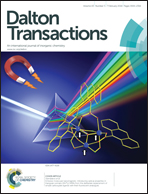Structural relationships among LiNaMg[PO4]F and Na2M[PO4]F (M = Mn–Ni, and Mg), and the magnetic structure of LiNaNi[PO4]F†
Abstract
The new compound LiNaMg[PO4]F has been synthesized by a wet chemical reaction route. Its crystal structure was determined from single-crystal X-ray diffraction data. LiNaMg[PO4]F crystallizes with the monoclinic pseudomerohedrally twinned LiNaNi[PO4]F structure, space group P21/c, a = 6.772(4), b = 11.154(6), c = 5.021(3) Å, β = 90.00(1)° and Z = 4. The structure contains [MgO3F]n chains made up of zigzag edge-sharing MgO4F2 octahedra. These chains are interlinked by PO4 tetrahedra forming 2D-Mg[PO4]F layers. The alkali metal atoms are well ordered in between these layers over two atomic positions. The use of group–subgroup transformation schemes in the Bärnighausen formalism enabled us to determine precise phase transition mechanisms from LiNaNi[PO4]F- to Na2M[PO4]F-type structures (M = Mn–Ni, and Mg) (see video clip 1 and 2). The crystal and magnetic structure and properties of the parent LiNaNi[PO4]F phase were also studied by magnetometry and neutron powder diffraction. Despite the rather long interlayer distance, dmin(Ni+2–Ni+2) ∼ 6.8 Å, the material develops a long-range magnetic order below 5 K. The magnetic structure can be viewed as antiferromagnetically coupled ferromagnetic layers with moments parallel to the b-axis.
![Graphical abstract: Structural relationships among LiNaMg[PO4]F and Na2M[PO4]F (M = Mn–Ni, and Mg), and the magnetic structure of LiNaNi[PO4]F](/en/Image/Get?imageInfo.ImageType=GA&imageInfo.ImageIdentifier.ManuscriptID=C3DT52587B&imageInfo.ImageIdentifier.Year=2014)

 Please wait while we load your content...
Please wait while we load your content...